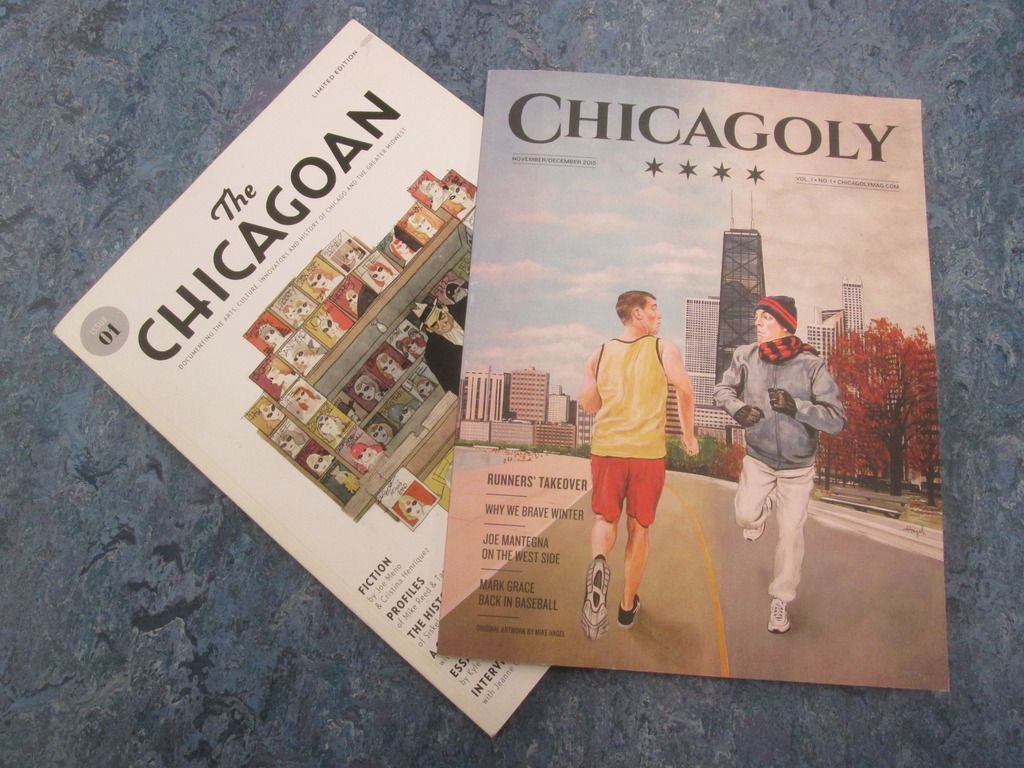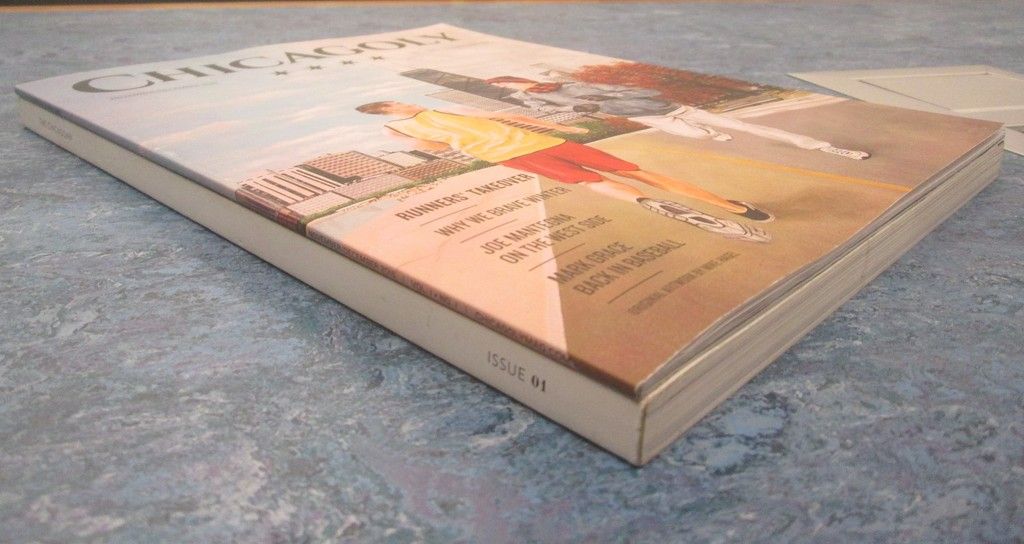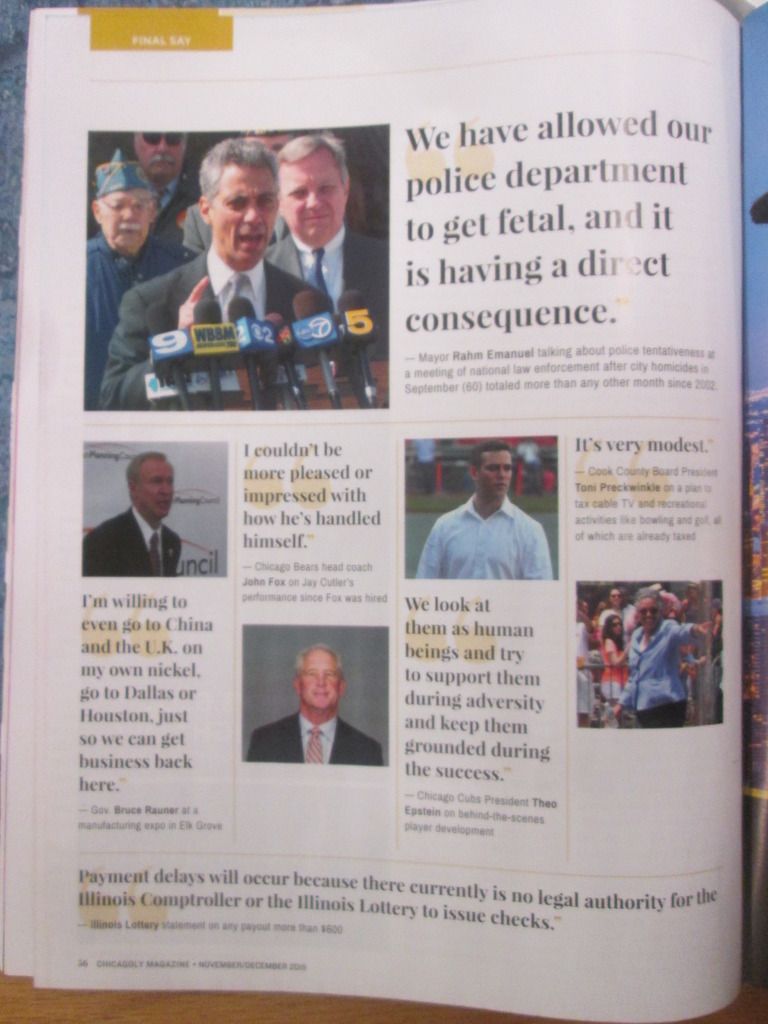Chicagoly - the not-quite-(re)rebirth of the Chicagoan magazine
Back in August I wrote about how 22nd Century Media - a newspaper company founded by a former Republic US Senate candidate Jack Ryan, a company that seems to have been successful in spite of being a newspaper company that launched in the 21st century - was planning to bring back The Chicagoan magazine, a Jazz Age culture and society magazine that stopped publishing in 1935. This was three years after J.C. Gabel, former publisher of Stop Smiling magazine, tried to launch his own revival - a very ambitious effort that didn't make it past its first issue.
Well, the first issue of the 22nd Century Media version of the Chicagoan came out last week. Sort of.

For one thing, you'll notice that it isn't actually called "The Chicagoan." Back in October 23, I got a Facebook notification that the page for the 22CM version of the Chicagoan was being merged with the page for... the Chicagoly magazine.
And this was the first thing I saw on that page
Leaving a unique and powerful footprint has always been important to 22nd Century Media. Creating original work is our...
Posted by Chicagoly Magazine on Thursday, October 22, 2015
As far as I know, 22nd Century Media never explained the name change. The issue itself certainly doesn't mention it. A week before the launch, Glenview Lantern (and, I suspect, all of the other 22nd Century Media newspapers) ran an editorial and a brief article about the impending debut, and they didn't mention the name change, either, let alone offer any explanation.
I know that, when the news originally broke, I tried to reach out to Gabel via Twitter - and he told me that he was told that the trademark lapsed and there was nothing he could do to prevent 22CM from using the name.
Whatever the reason may be, my first response to the name change was incredulity. Even if you didn't know the history behind "The Chicagoan" name, it still a name that means something. It implies a magazine for Chicagoans, perhaps something similar to New Yorker. What the heck is a "Chicagoly?"
And here's an interesting fact. It turned out that, while Chicagoly is way thinner than Gabel's version of the Chicagoan, they have the same page size. The difference is in milometers at best.

But taking the silly name and the reasons behind it aside - what is Chicagoly like as a magazine?
And, having reread it a few times, the best I can muster is "it's alright, I guess."
It isn't that it doesn't have some interesting stuff. There is an article about the assassination of Chicago mayor Carter Harrison during the final stretch of the 1893 World's Fair, which sheds the light on then-significant, but now all-but-forgotten event. The pieces on the place of Boy Scouts in modern American society is legitimately thought-provoking, and the piece on very competitive suburban soccer teams makes the whole thing sounds pretty involving and interesting to someone who has no stake in the issue whatsoever.
There is also an oral interview of Criminal Minds star Joe Mantegna, who talks about growing up on the West Side of Chicago. It interests me as historian - though it was hard not to notice one glaring omission. Mantegna talks about his family leaving East Garfield Park for the suburban Cicero without ever explaining why. Anyone who is familiar with Chicago history don't need an explanation. While describing it as "Black people moved into our neighborhood so we ran the hell away" doesn't capture all of the nuances of this controversial part of Chicago history, racism - and fears that having black people in the neighborhood would make the quality of life worse - definitely played a role.
Having an otherwise candid account leave that part is, like I said, glaring.
And then, there's the conservative bias.
Most of the articles are ideologically neutral. Even Mantegna's piece, while not immune to nostalgia and a bit selective in terms of history, is not particularly apolitical. But once you flip past the introductory editorial, you get "the world we live in," musings by Joe Coughlin, current publisher of Chicagoly (and other 22nd Century Media publications). The first bit complains about teachers' union strikes (while carefully trying not to blame individual teachers). The third piece complains about taxes driving away businesses. The fourth piece blames the pension crisis on "bad contracts, effective labor unions, public officials" (emphasis mine).
The second bit, which decries former Chicago Public Schools' CEO Barbara Byrd-Bennet, can't really be called politically biased, since nobody would argue that what Byrd did was in any way justifiable. That and it praises the generally left-leaning Catalyst Chicago magazine. The fifth piece doesn't have anything to do with politics at all.
And then, there's the final page. Look at what quotes were selected. The quote from Emanuel echoes the talking point among more right-leaning media outlets - that the controversy over the shooting of Michael Brown and other black youths was making the police less effective. The quote from Cook County Board President deals with tax increases. The quote from Gov. Bruce Rauner emphasizes his "pro-business" approach.

It's no secret that, in terms of editorial viewpoint, 22nd Century Media newspapers tend to lean right. The endorsements and enormous Bruce Rauner ads during the last election make it clear. And, so long as it doesn't creep into straight news, there is nothing wrong with that. Chicago Tribune's editorial board is notoriously conservative on economic and education issues. Daily Herald, a suburban daily newspaper, isn't much different. Crain's Chicago Business tends to be economically liberal in a classical sense. Glenview Journal, one of Glenview Lantern's competitors, tends to be more on a liberal side. So is Evanston Roundtable. The Chicago Reader and Newcity tend to lean a bit further left, but not by much. And Lumpen is, as I've often joked, for those who think Reader is just too conservative.
There are many examples of magazines that have ideological tints. Even if you rule out political magazines like Mother Jones, National Review, New Republic and Reason, there is the Economist's classical economic liberalism, Rolling Stone's left-leaning sympathies, etc.
But when you look at the more general interest Chicago magazines... Chicago is probably more left leaning than the Trib, but it's not that terribly ideological. Evanston Magazine serves a famously left-leaning city, and some of its articles reflect that. Chicago Social and North Shore focus on topics of interests to primary demographic (rich people), which can make them a bit oblivious to social issues, but it's not overtly political. Neither is Make it Better magazine.
I suppose there is nothing wrong with Chicagoly having a conservative tilt. And I don't think it's quite overt enough to drive away any left-leaning readers. At least not per se. But it's not something that can just be overlooked, either.
Ultimately, more than anything, I find myself underwhelmed. Over the past two weeks, I kept trying to figure out why. Like I said, there were articles I liked, articles that interested me. Yet, to be honest, I don't really feel interested enough to pick up another issue.
When I picked up Gabel's Chicagoan it felt exciting and new. It had striking design, interesting voices and articles that experimented with the format. None of that can be said about Chicagoly.
Ultimately, conservative leanings aside, it doesn't really have anything I can't find in Chicago, or Chicago Social, or Make it Better, or Michigan Avenue, or NS. While I've had some issues with FW:Chicago, it had a strong identity. And, ultimately, I'm not convinced that Chicagoly has much of an identity at all.
Having said all that - there is one major reason why I am inclined to keep looking at it. In the introductory editorial, Coughlin mentioned that he hopes that, eventually, "Chicagoly can expand its touch and its pages with possible additions of original short stories, fiction, reviews, poetry, and maybe more."
That was something that Gabel's The Chicagoan tried. In Chicago area, fiction markets, let alone fiction markets that pay, are a rare thing. And something that publishes more than once a year is a rarer still.
If Chicagoly actually pulls it off... that would make the magazine stand out.
---
Chicagoly is distributed throughout Chicago and its suburbs. Its official website has a map of distribution points, but I know for a fact that some of those points haven't gotten any copies as of this writing, and I've been told that copies turned up in locations that weren't on the map. I personally picked up a few copies atop of one of the mysterious white newspaper boxes, which definitely weren't on the map (speaking of which, since I wrote this post, I still have no idea what they're for, and neither does anyone else I talked to).
If nothing else, the official map might make a good starting point. Good luck!
Well, the first issue of the 22nd Century Media version of the Chicagoan came out last week. Sort of.

For one thing, you'll notice that it isn't actually called "The Chicagoan." Back in October 23, I got a Facebook notification that the page for the 22CM version of the Chicagoan was being merged with the page for... the Chicagoly magazine.
And this was the first thing I saw on that page
Leaving a unique and powerful footprint has always been important to 22nd Century Media. Creating original work is our...
Posted by Chicagoly Magazine on Thursday, October 22, 2015
As far as I know, 22nd Century Media never explained the name change. The issue itself certainly doesn't mention it. A week before the launch, Glenview Lantern (and, I suspect, all of the other 22nd Century Media newspapers) ran an editorial and a brief article about the impending debut, and they didn't mention the name change, either, let alone offer any explanation.
I know that, when the news originally broke, I tried to reach out to Gabel via Twitter - and he told me that he was told that the trademark lapsed and there was nothing he could do to prevent 22CM from using the name.
Whatever the reason may be, my first response to the name change was incredulity. Even if you didn't know the history behind "The Chicagoan" name, it still a name that means something. It implies a magazine for Chicagoans, perhaps something similar to New Yorker. What the heck is a "Chicagoly?"
And here's an interesting fact. It turned out that, while Chicagoly is way thinner than Gabel's version of the Chicagoan, they have the same page size. The difference is in milometers at best.

But taking the silly name and the reasons behind it aside - what is Chicagoly like as a magazine?
And, having reread it a few times, the best I can muster is "it's alright, I guess."
It isn't that it doesn't have some interesting stuff. There is an article about the assassination of Chicago mayor Carter Harrison during the final stretch of the 1893 World's Fair, which sheds the light on then-significant, but now all-but-forgotten event. The pieces on the place of Boy Scouts in modern American society is legitimately thought-provoking, and the piece on very competitive suburban soccer teams makes the whole thing sounds pretty involving and interesting to someone who has no stake in the issue whatsoever.
There is also an oral interview of Criminal Minds star Joe Mantegna, who talks about growing up on the West Side of Chicago. It interests me as historian - though it was hard not to notice one glaring omission. Mantegna talks about his family leaving East Garfield Park for the suburban Cicero without ever explaining why. Anyone who is familiar with Chicago history don't need an explanation. While describing it as "Black people moved into our neighborhood so we ran the hell away" doesn't capture all of the nuances of this controversial part of Chicago history, racism - and fears that having black people in the neighborhood would make the quality of life worse - definitely played a role.
Having an otherwise candid account leave that part is, like I said, glaring.
And then, there's the conservative bias.
Most of the articles are ideologically neutral. Even Mantegna's piece, while not immune to nostalgia and a bit selective in terms of history, is not particularly apolitical. But once you flip past the introductory editorial, you get "the world we live in," musings by Joe Coughlin, current publisher of Chicagoly (and other 22nd Century Media publications). The first bit complains about teachers' union strikes (while carefully trying not to blame individual teachers). The third piece complains about taxes driving away businesses. The fourth piece blames the pension crisis on "bad contracts, effective labor unions, public officials" (emphasis mine).
The second bit, which decries former Chicago Public Schools' CEO Barbara Byrd-Bennet, can't really be called politically biased, since nobody would argue that what Byrd did was in any way justifiable. That and it praises the generally left-leaning Catalyst Chicago magazine. The fifth piece doesn't have anything to do with politics at all.
And then, there's the final page. Look at what quotes were selected. The quote from Emanuel echoes the talking point among more right-leaning media outlets - that the controversy over the shooting of Michael Brown and other black youths was making the police less effective. The quote from Cook County Board President deals with tax increases. The quote from Gov. Bruce Rauner emphasizes his "pro-business" approach.

It's no secret that, in terms of editorial viewpoint, 22nd Century Media newspapers tend to lean right. The endorsements and enormous Bruce Rauner ads during the last election make it clear. And, so long as it doesn't creep into straight news, there is nothing wrong with that. Chicago Tribune's editorial board is notoriously conservative on economic and education issues. Daily Herald, a suburban daily newspaper, isn't much different. Crain's Chicago Business tends to be economically liberal in a classical sense. Glenview Journal, one of Glenview Lantern's competitors, tends to be more on a liberal side. So is Evanston Roundtable. The Chicago Reader and Newcity tend to lean a bit further left, but not by much. And Lumpen is, as I've often joked, for those who think Reader is just too conservative.
There are many examples of magazines that have ideological tints. Even if you rule out political magazines like Mother Jones, National Review, New Republic and Reason, there is the Economist's classical economic liberalism, Rolling Stone's left-leaning sympathies, etc.
But when you look at the more general interest Chicago magazines... Chicago is probably more left leaning than the Trib, but it's not that terribly ideological. Evanston Magazine serves a famously left-leaning city, and some of its articles reflect that. Chicago Social and North Shore focus on topics of interests to primary demographic (rich people), which can make them a bit oblivious to social issues, but it's not overtly political. Neither is Make it Better magazine.
I suppose there is nothing wrong with Chicagoly having a conservative tilt. And I don't think it's quite overt enough to drive away any left-leaning readers. At least not per se. But it's not something that can just be overlooked, either.
Ultimately, more than anything, I find myself underwhelmed. Over the past two weeks, I kept trying to figure out why. Like I said, there were articles I liked, articles that interested me. Yet, to be honest, I don't really feel interested enough to pick up another issue.
When I picked up Gabel's Chicagoan it felt exciting and new. It had striking design, interesting voices and articles that experimented with the format. None of that can be said about Chicagoly.
Ultimately, conservative leanings aside, it doesn't really have anything I can't find in Chicago, or Chicago Social, or Make it Better, or Michigan Avenue, or NS. While I've had some issues with FW:Chicago, it had a strong identity. And, ultimately, I'm not convinced that Chicagoly has much of an identity at all.
Having said all that - there is one major reason why I am inclined to keep looking at it. In the introductory editorial, Coughlin mentioned that he hopes that, eventually, "Chicagoly can expand its touch and its pages with possible additions of original short stories, fiction, reviews, poetry, and maybe more."
That was something that Gabel's The Chicagoan tried. In Chicago area, fiction markets, let alone fiction markets that pay, are a rare thing. And something that publishes more than once a year is a rarer still.
If Chicagoly actually pulls it off... that would make the magazine stand out.
---
Chicagoly is distributed throughout Chicago and its suburbs. Its official website has a map of distribution points, but I know for a fact that some of those points haven't gotten any copies as of this writing, and I've been told that copies turned up in locations that weren't on the map. I personally picked up a few copies atop of one of the mysterious white newspaper boxes, which definitely weren't on the map (speaking of which, since I wrote this post, I still have no idea what they're for, and neither does anyone else I talked to).
If nothing else, the official map might make a good starting point. Good luck!